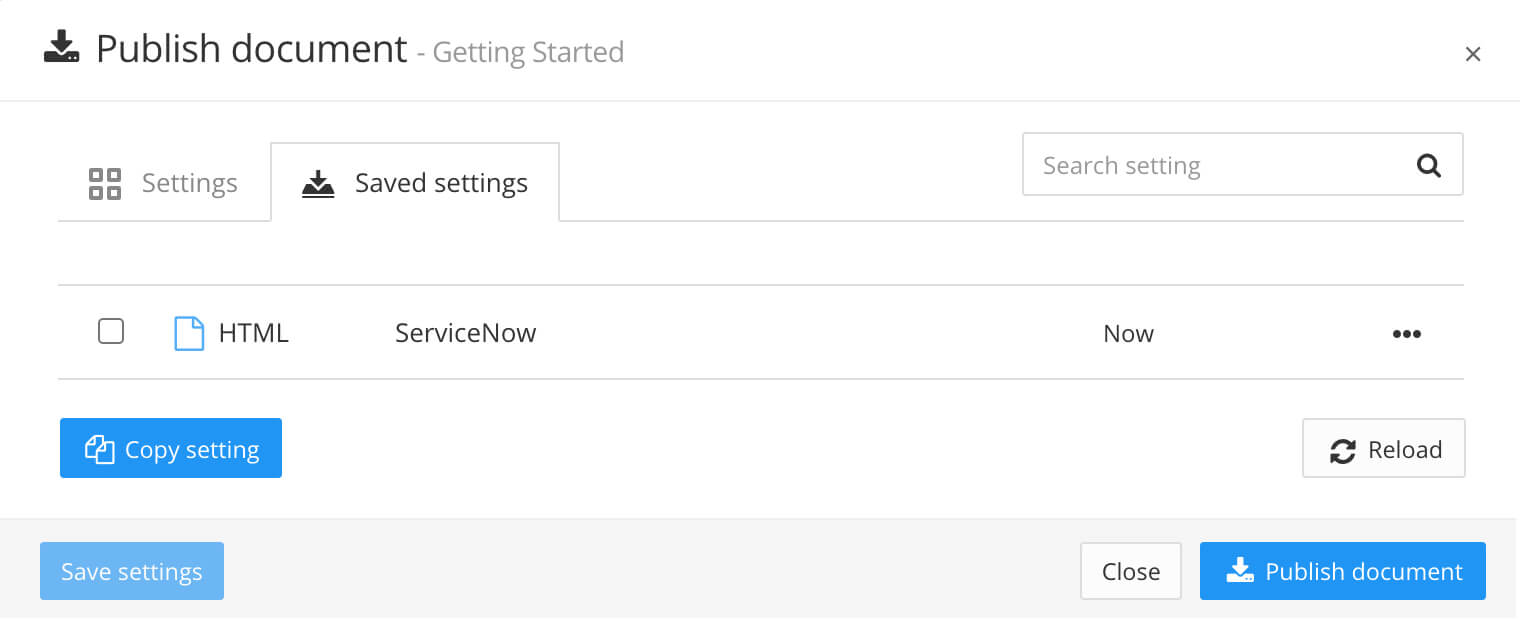Azure Repos Integration
Paligo has Continuous Integration (CI) support for Microsoft® Azure Repos®. This means you can create content in Paligo, such as PDFs or an HTML help center and publish it to Azure Repos. The content is uploaded to your choice of Azure repo as a zipped file.
 |
Prerequisites to be able to activate this integration:
An Azure Repos account
Basic Azure Repose knowledge and skills, including how to create a project, repository, and personal access token
A project in Azure Repos
A repository in Azure Repos. The repository must be inside a project. Paligo will upload the zip file for the published output to this repository.
Note
The Paligo to Azure upload has a limit of approximately 20 MB.
Once the Azure SSO setup has been done, you need the following details from your Azure Repos account to connect Paligo to it:
Organization
Username
Personal Access Token. You can create a Personal Access Token in the User Settings in Azure Repos.
When the connection is made, you can Publish to Azure Repos.
Log in to Paligo via a user account that has administrator permissions.
Sign in to Paligo using a user account that has administrator permissions.
Select the avatar in the top-right corner.

Select Settings from the menu.

Select the Integrations and webhooks tab.

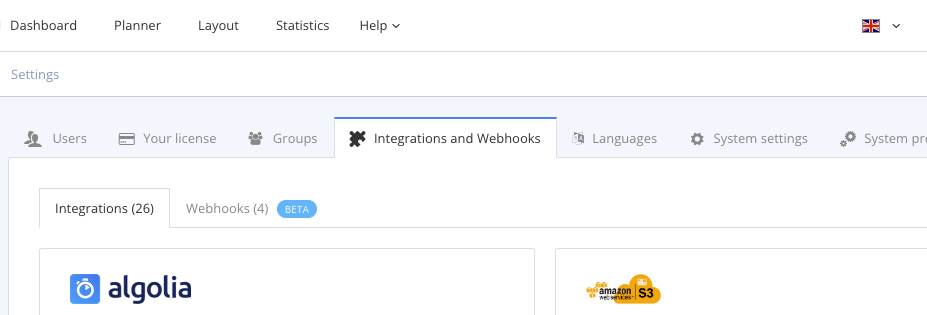
Find the Azure Repos settings and select Add.
Note
Add is only available the first time you set up an integration. After that, Add is replaced by Change.
Paligo displays the Azure Repos integration settings:
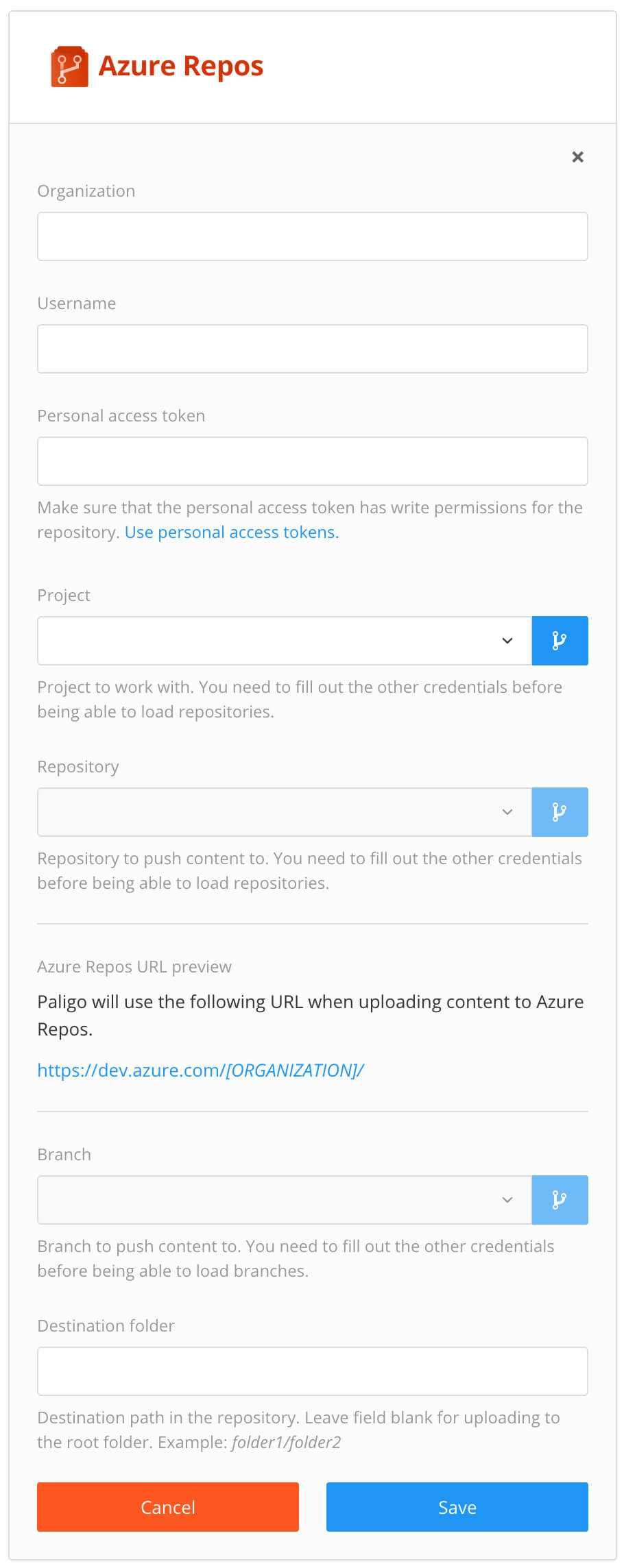
Enter the Organization. Typically, this is your username but without the email address part, for example, if your username is jsmith@gmail.com, the Organization is likely to be jsmith.
Enter the Username for the Azure Repos account. Paligo will use this to log in to Azure Repos. It is important that the account has write permissions for the repository (these are set for the account in Azure Repos).
Enter the Personal Access Token. You can create the Personal Access Token in Azure Repos.
Select the button at the end of the Project field. Paligo connects to Azure Repos and detects the projects that you have available. Select the project that contains the repository that you want Paligo to publish to.

Select the Repository that you want Paligo to publish to.
Choose the Branch that Paligo will upload content to.
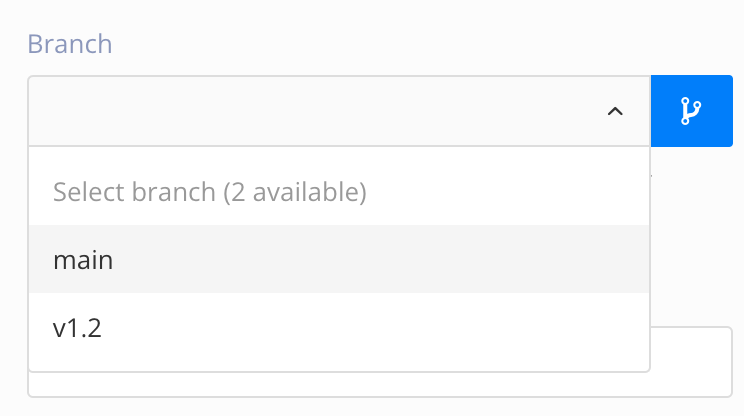
If the Branch field is empty (or if a branch is missing), select the branch button to load the branches. Then choose the branch from the dropdown list.

Note
If the integration setting is open when new branches are added, those new branches will not appear in the Branch field unless the integration setting is reloaded.
Select the branch button, to reload the integration setting with the latest branch information.
As Destination folder, you enter the directory path for the folder that you want Paligo to upload content to.
To upload the zip file directly to the root, leave this field empty.

Select Use non-unique filename if you want to use the same filename for every upload of the same document. This will attach a timestamp to the zip-file that is output.
Select Save.
Select the Change button for the integration.
Select Test Settings to run a connection test.

If the settings are:
Correct, Paligo shows a green success notification.
Incorrect, Paligo shows a red failure notification.
Check each connection setting carefully, to make sure you have not made any mistakes and try again.
If the connection test continues to fail, contact Paligo support for assistance.
You can publish content from Paligo to Azure Repos, and the process is very similar to "regular" publishing. You create your publication and topics, and set up a layout for the type of output you want, such as PDF, HTML5, etc. Then you choose the publication settings and Paligo creates a zip file that contains your output content. The zip file is downloaded in your browser and it is also uploaded to your chosen Azure Repos repository.
To publish from Paligo to Azure Repos, use the Upload to Azure Repose option in the publishing settings. This option is only available if the Paligo Azure Repos integration settings are in place. You will also need to set up a publication and layout to create the output you want, for example, an HTML5 help center. With these in place, you can publish from Paligo to Azure Repos.
Note
The Paligo to Azure upload has a limit of approximately 20 MB.
Select the dotted menu (...) for the topic or publication in the Content Manager.
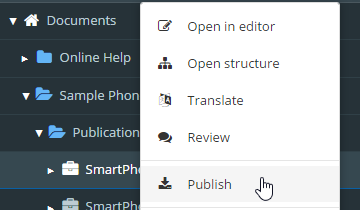
Select Publish.
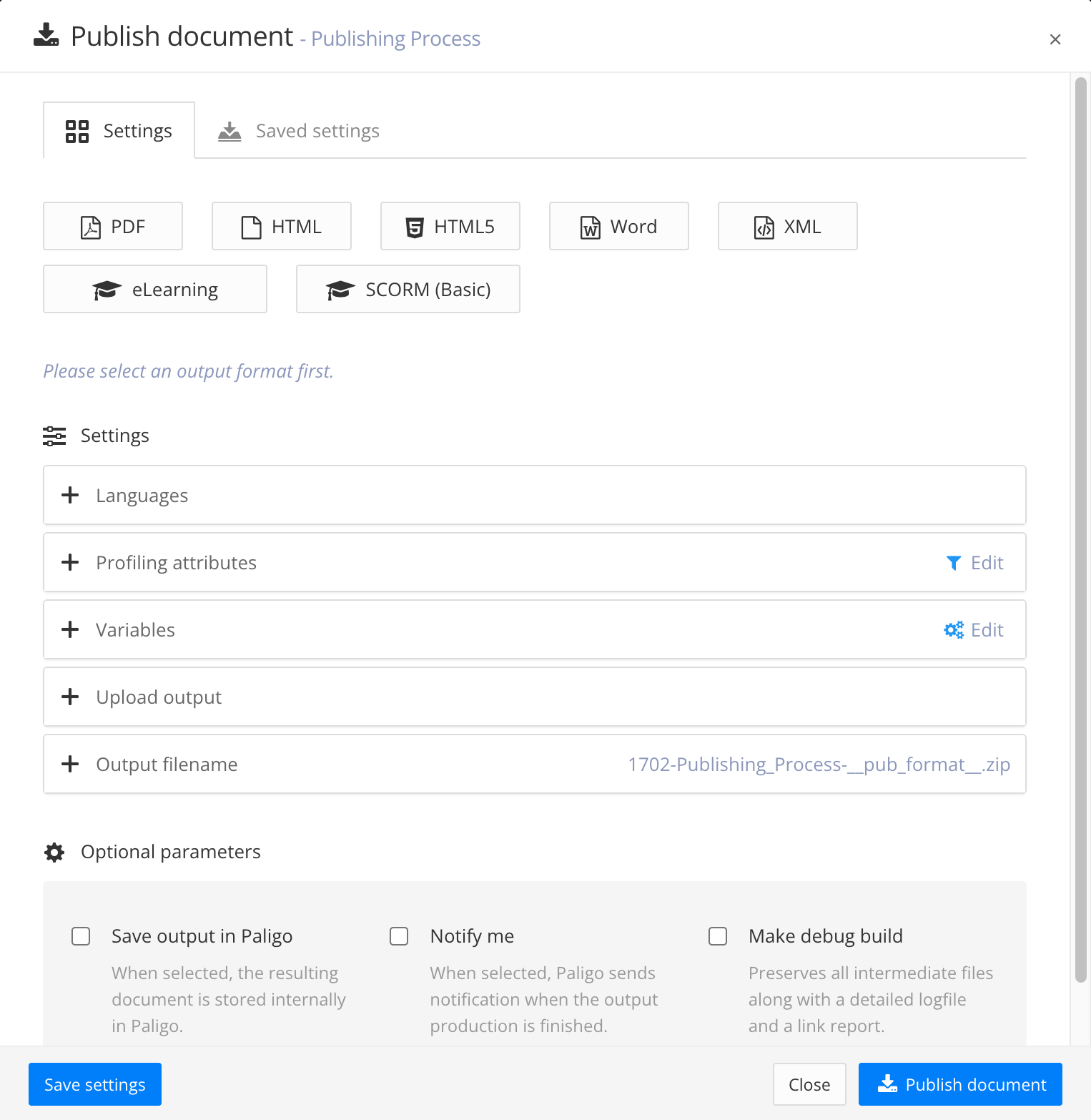
Paligo displays the Publish document dialog.
Select the Type of output you want to publish (for example PDF, HTML, HTML5, Word, XML, eLearning, SCORM, or other).
Select the Layout to be used for your output.
Select the languages to be published.

Note
If no translations are available, only the Source Language will show. If you have multiple languages translated and approved, you can select which ones to include. Paligo will publish each language as a separate output.
For PDF output you can publish them as one multilingual publication, check the Combine selected languages box.
If your content is set up to use Filtering / Profiling, use the Profiling attributes section to apply them. [Optional]. If you do not use filtering, ignore this setting.
Select Edit and then choose the value for each filter that you want Paligo to use. For example, for Audience, choose Expert to include content that is marked as for expert users.
If you do not want to apply a filter, leave the field blank.

Select OK to add your chosen profiling attribute(s).

In the Upload output section, check the Upload to Azure Repos box.
By default, Paligo will upload the output to the repository and folder that are specified in the Paligo to Azure Repos integration settings.

You can publish to a different branch or folder if required. Select the Edit icon next to Upload to Azure Repos, and then select the branch and/or folder on the Edit dialog.
The settings you choose will only be used for this individual publishing process. Any future publishing will revert back to using the branch and folder that are defined in the integration settings.

Use the Output filename section to control the filename.
By default, Paligo will use the filename syntax that is defined in the System Settings.

To change the information included in the filename, enter your preferred format in the publishing settings. Default is:
ID-Title-Format.You can use:
ID - The ID of the document.
Title - The title of the publication or topic that you are publishing.
Format - The name of the output format, for example, PDF or HTML5.
Edit date - The date that the publication or topic was last edited.
Branch label - The text from the branch label for the publication or topic. This only applies if your content has been branched and it has a branch label. For details, see Add or Edit Branch Labels.
Unique value - A random string of characters, generated by Paligo, that is added to the filename to make it unique. This can stop the file from being overwritten by later publishes of the same document.
Tip
If you type @ into the field, Paligo displays a list of the available values and you can select from the list. To remove a value, click in it and use the delete key or backspace key to remove all of its characters.
Note
The filename shown in the top-right corner is a preview of the filename that Paligo will use when you publish.
Set the Optional Parameters (leave unchecked if you do not want these features):
Save the output in Paligo - Check the box to save the zip file that Paligo creates when you publish. The zip file will be available from the Resource View and you can download it from the Saved Outputs tab. Clear the box if you don't want Paligo to store the zip file.
Notify me - Check this box if you want Paligo to send you an email when the publication is ready. This is useful if you have very large publications that can take a longer time to process and publish.
Make debug build - Check this box if you want Paligo to include a log file and link report. If there is an issue with your content, Paligo support may ask you to enable this feature so that they can use the log files to investigate.
Select Publish Document.
Paligo starts processing your content and applies your layout and publishing settings. The time that this takes varies depending on how much content you are publishing (the more content, the longer it takes).

A progress bar appears. Select the arrow to hide the progress bar and reopen it by selecting the progress clock in the top menu. To abort the publish, select the X.
The published output appears as:
A ZIP file with the published output appears in the downloads folder on your computer.
If you have altered your browser's settings to store downloaded files somewhere else, the zip file will be found there instead.
If you are using a publishing integration, the zip file will also be sent to the relevant service.
A link in the Activity Feed Panel to download the published content.
Note
To make the content available online, first unzip the file. You can then use the file locally or you can use an FTP client, such as Filezilla, to upload the unzipped content to a web server.
Tip
You can save your publishing settings and reuse them to achieve a smoother publishing process, see Publishing Settings. Any settings you save can also be used for Batch Publishing.
